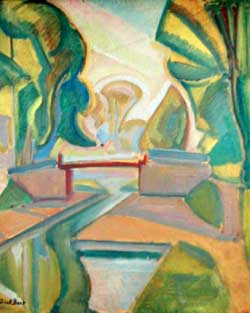Dick Beer had many reasons to love France, But at this time he exhibits mostly in Sweden. In 1916 he shows part of his production at the famous Valand gallery in Gothenburg. The year after he meets Paul Signac in Paris, shows the master his recent works and receives some flattering encouragements:
“Technically, it is difficult to do more than what you already achieve”, Signac told him.
In 1917 he also paints the model Jeannot sitting in a deck chair, a very delicate picture confirming that he is about to abandon the impressionist way of expressing himself. Evolving with new techniques and forms is partly out of curiosity, but Beer feels the profound necessity to move on. Beginning in 1917 with a fresh look upon reality, he becomes cubist the year after. For him it is not a question of being against nature (he is no futurist), it represents essentially a manner to apprehend nature differently:
“The cubist is the realist and the dreamer in one. He enjoys and is thrilled by the capacity to pierce forms and volumes, to analyse, scrutinize and touch objects. This quest for exactness does not content itself with what our ephemeral eyes may perceive in nature. The cubist wants to go further, always further in the great mystery. The cubist has its forms; volumes, his plastic and colours. There are rhythms in nature, of which the intrinsic aesthetics can not be discerned visually, that only simmering emotions may capture”, he writes in 1919.

Kubistisk park, 1919
And he explains the evolution :
”From 1908 to 1918 I have changed a lot artistically and I think this progression is understandable, even if some people seem to take pleasure in interpreting it wrongly. Very young I had a first naturalist period between 1908 and 1912 which certainly was not impressionism. Then I passed to the colour technique of divisionism, clearly an impressionist one, where paint and forms are dissolved. In 1913-1914, we may talk of neo-impressionism. In 1914 and throughout 1915, it is still a work of dissolving colours. Then comes a period 1916-1917 which should be seen as a transition, culminating in the year 1919. It is without any doubt the word intensity which best resumes my present search in form and colours.”
(Continued)